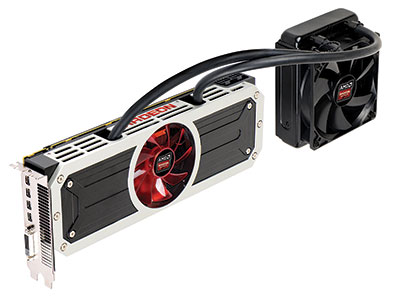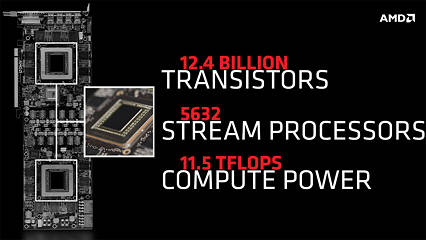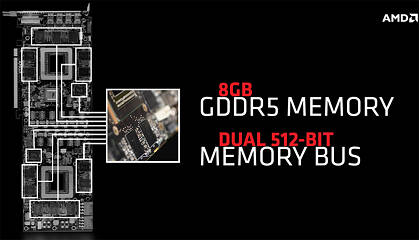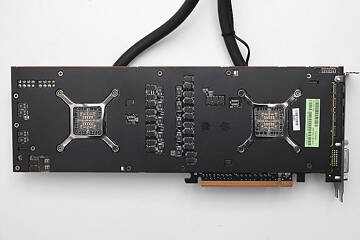 121
121
AMD Radeon R9 295X2 8 GB Review
(121 Comments) »Introduction

Had someone told us back in October 2013 that AMD could possibly create a dual-GPU graphics card based on its fast-yet-feisty "Hawaii" silicon with all the GPU units enabled and as a two-slot card that draws its power out of just two 8-pin connectors, we'd have asked them what they were smoking and if we could have some of that stuff. Well, they now stand vindicated because the new Radeon R9 295X2 is a 30 cm-long two-slot card alright, although it also lugs along a 120 mm radiator and factory-fitted tubing that you'll have to find room in your case for (more so if you already have a liquid CPU cooler installed).
The design goals for the Radeon R9 295X2 couldn't be more clear – to offer a no-nonsense CrossFire-on-a-stick solution made up of two R9 290X chips. The idea is to pack enough graphics processing muscle into one card to make any game out there playable at 4K/60Hz, with the eye-candy cranked up. The display output configuration of four mini-DP 1.2 and a dual-link DVI should inspire multi-display gamers.
There was simply no way AMD could have done two things with this card – one, to completely air-cool the card as a dual-slot solution and, two, to power two 250W chips with just two 8-pin power connectors.
AMD overcame the first hurdle by turning to water-cooling OEM giant Asetek for an innovative cooling solution, a factory-fitted, closed-loop cooler with two block + pump assemblies serially plumbed to a single 120 mm radiator + reservoir assembly. The radiator may look inadequate at first, but our temperature measurements show that AMD managed to make it work without overheating. The card still has a 100 mm red LED-lit fan, which cools the centrally located VRM heatsink and the base-plate that cools the memory and bridge chip.
The second hurdle was overcome, of course, by breaching ATX specifications and drawing more power than allowed from the two 8-pin power connectors. For the Radeon R9 295X2, AMD recommends that the plugs powering the card are wired to a +12V rail on your PSU with at least 28A of current on tap per plug. Looking at these power requirements, we are forced to at least recommend a 750W PSU for a build with one of these cards, preferably one with a single +12V rail design and a decent efficiency rating.
Under the hood, the Radeon R9 295X2 is every bit a duo of two R9 290X GPUs. Each of the two 6.2 billion-transistor GPUs has all its 2,816 GCN2 stream processors enabled, along with 176 texture memory units, 64 ROPs, and 512-bit wide GDDR5 memory interfaces that each hold 4 GB of memory for a total of 8 GB on the card, which should be more than enough memory for any display configuration you can try out with this card.

At US $1,499, the Radeon R9 295X2 is about $400 more expensive than two R9 290X cards, which looks steep, but is nowhere as obnoxious as the $3000 NVIDIA will ask for its GeForce GTX TITAN-Z since that is $1000 costlier than buying a pair of GTX TITAN-Black cards. In a way, NVIDIA’s marketing arrogance is working in AMD's favor. Despite being a $1500 card, which is 50% costlier than its predecessor, the HD 7990, and a stunning 115% costlier than the HD 6990, it ends up looking like a good option on paper. That said, our review will show how well the R9 295X2 holds up in practice.
| GeForce GTX 780 | Radeon R9 290 | Radeon R9 290X | Radeon HD 7990 | GeForce GTX Titan | GeForce GTX 780 Ti | GeForce GTX 690 | Radeon R9 295X2 | |
|---|---|---|---|---|---|---|---|---|
| Shader Units | 2304 | 2560 | 2816 | 2x 2048 | 2688 | 2880 | 2x 1536 | 2x 2816 |
| ROPs | 48 | 64 | 64 | 2x 32 | 48 | 48 | 2x 32 | 2x 64 |
| Graphics Processor | GK110 | Hawaii | Hawaii | 2x Tahiti | GK110 | GK110 | 2x GK104 | 2x Hawaii |
| Transistors | 7100M | 6200M | 6200M | 2x 4310M | 7100M | 7100M | 2x 3500M | 2x 6200M |
| Memory Size | 3072 MB | 4096 MB | 4096 MB | 2x 3072 MB | 6144 MB | 3072 MB | 2x 2048 MB | 2x 4096 MB |
| Memory Bus Width | 384 bit | 512 bit | 512 bit | 2x 384 bit | 384 bit | 384 bit | 2x 256 bit | 2x 512 bit |
| Core Clock | 863 MHz+ | 947 MHz | 1000 MHz | 1000 MHz | 837 MHz+ | 876 MHz+ | 915 MHz+ | 1018 MHz |
| Memory Clock | 1502 MHz | 1250 MHz | 1250 MHz | 1500 MHz | 1502 MHz | 1750 MHz | 1502 MHz | 1250 MHz |
| Price | $480 | $460 | $570 | $900 | $1000 | $660 | $1000 | $1500 |
Packaging
Our review sample arrived in a sexy aluminum suitcase. Whether retail cards are presented as nicely is unknown. I requested clarification from AMD.
The Card
AMD's latest card looks a bit plasticky despite its metal fan shroud. The metal allen head screws are real metal and are, even though they do not serve no real function, still a nice touch. With a length of 30 cm, the R9 295X2 is quite long, but it is also only 11 cm tall.
AMD's card itself is two slots thick. You should leave some below the bottom of the card to provide its fan with fresh air. So make sure to, for example, leave one free slot below the card in CrossFire. The drawing above illustrates how you should mount the 120 mm watercooling radiator.
Display connectivity options include one DVI port and four mini-DisplayPorts. You may use all outputs at the same time, so triple-monitor surround gaming is possible with one card, even more so if you use a MST DisplayPort hub.
The GPU also includes an HDMI sound device. It is HDMI 1.4a compatible, which includes HD audio and Blu-ray 3D movies support.
A physical CrossFire connector is not present as all Hawaii-based GPUs send their CrossFire data via the PCI-Express bus.
Pictured above are the front and back, showing the disassembled board. High-res versions are also available (front, back).
A Closer Look
AMD designed a complex heatsink base that covers all memory chips, the entire voltage regulation circuitry, and the PCI-Express bridge chip. You can also see the circular copper bases of both GPU watercooling blocks to the right and left.
Under the hood, we can clearly see the Asetek technology used. The large heatsink in the middle is used to cool the VRM circuitry.
The metal backplate cools the memory chips on the backside of the card. It comes with a cutout in its center for the VRM circuitry, which tends to get quite hot (100°C+).
Firmly attached to the blocks and without any accessible clamps or anything similar, the watercooling hoses very safe to use. It's almost impossible to rip them off the blocks or otherwise damage the thick rubber that's also quite resistant to kinking.
The card requires two 8-pin PCI-Express power connectors. This configuration would normally be good for up to 375 W of power draw. AMD, however, has chosen to trump those specifications and cites a minimum of 28A (=336 W) for each connector, which brings the total to around 750 W. I think AMD exaggerates a bit, but you had better be safe than sorry. In actual usage we see power draw peak at 650 W, which makes 25A per connector enough. Nevertheless, this configuration greatly exceeds the PCI-Express specifications, so you should not use a weak or poorly built PSU with this card.
Just like most of their other recent cards, AMD has equipped the R9 295X2 with a dual-BIOS feature that can be useful when it comes to recovering the video BIOS in case of a flashing failure. Both BIOSes are also exactly the same in their default configuration as there is no quiet/performance mode like on the R9 290X.
AMD is using two NCP81022 voltage controllers on the card, one for each GPU. This is the same controller as on Bonaire-based GPUs. Both Hawaii and Bonaire have a new capability as they can drive special voltage controllers faster than other GPUs, which means voltages can be adjusted more quickly and efficiently. Software voltage control should be possible, but is not supported by any software yet.
The PEX8747 48 lane PCI-Express Gen 3 Bridge chip is the latest in PLX's arsenal of PCIe bridge chip solutions. It is used to link the two GPUs and connects them to the rest of the system.
The GDDR5 memory chips are made by SKhynix and carry the model number H5GC2H24BFR-T2C. They are specified to run at 1250 MHz (5000 MHz GDDR5 effective).
AMD's Hawaii graphics processor uses the GCN shader architecture. It is produced on a 28 nm process at TSMC, Taiwan, with 6.2 billion transistors on a 438 mm² die.
Our Patreon Silver Supporters can read articles in single-page format.
Apr 26th, 2024 17:15 EDT
change timezone
Latest GPU Drivers
New Forum Posts
- Only EDP Other in Core? (2)
- What's your latest tech purchase? (20353)
- Alphacool CORE 1 CPU block - bulging with danger of splitting? (30)
- Dell Workstation Owners Club (3061)
- Xeon Owners Club (8700)
- Secure boot already open help (10)
- hacked (77)
- Best SSD for system drive (92)
- looking to build a new system and im considering asrock brand but i have some doubts/concerns. (4)
- Meta Horizon OS (22)
Popular Reviews
- HYTE THICC Q60 240 mm AIO Review
- MOONDROP x Crinacle DUSK In-Ear Monitors Review - The Last 5%
- Upcoming Hardware Launches 2023 (Updated Feb 2024)
- Alienware Pro Wireless Gaming Keyboard Review
- Thermalright Phantom Spirit 120 EVO Review
- FiiO K19 Desktop DAC/Headphone Amplifier Review
- ASUS Radeon RX 7900 GRE TUF OC Review
- AMD Ryzen 7 7800X3D Review - The Best Gaming CPU
- RTX 4090 & 53 Games: Ryzen 7 5800X vs Ryzen 7 5800X3D Review
- Sapphire Radeon RX 7900 GRE Pulse Review
Controversial News Posts
- Windows 11 Now Officially Adware as Microsoft Embeds Ads in the Start Menu (135)
- Sony PlayStation 5 Pro Specifications Confirmed, Console Arrives Before Holidays (117)
- NVIDIA Points Intel Raptor Lake CPU Users to Get Help from Intel Amid System Instability Issues (106)
- AMD "Strix Halo" Zen 5 Mobile Processor Pictured: Chiplet-based, Uses 256-bit LPDDR5X (103)
- US Government Wants Nuclear Plants to Offload AI Data Center Expansion (98)
- AMD's RDNA 4 GPUs Could Stick with 18 Gbps GDDR6 Memory (95)
- Developers of Outpost Infinity Siege Recommend Underclocking i9-13900K and i9-14900K for Stability on Machines with RTX 4090 (85)
- Windows 10 Security Updates to Cost $61 After 2025, $427 by 2028 (84)































